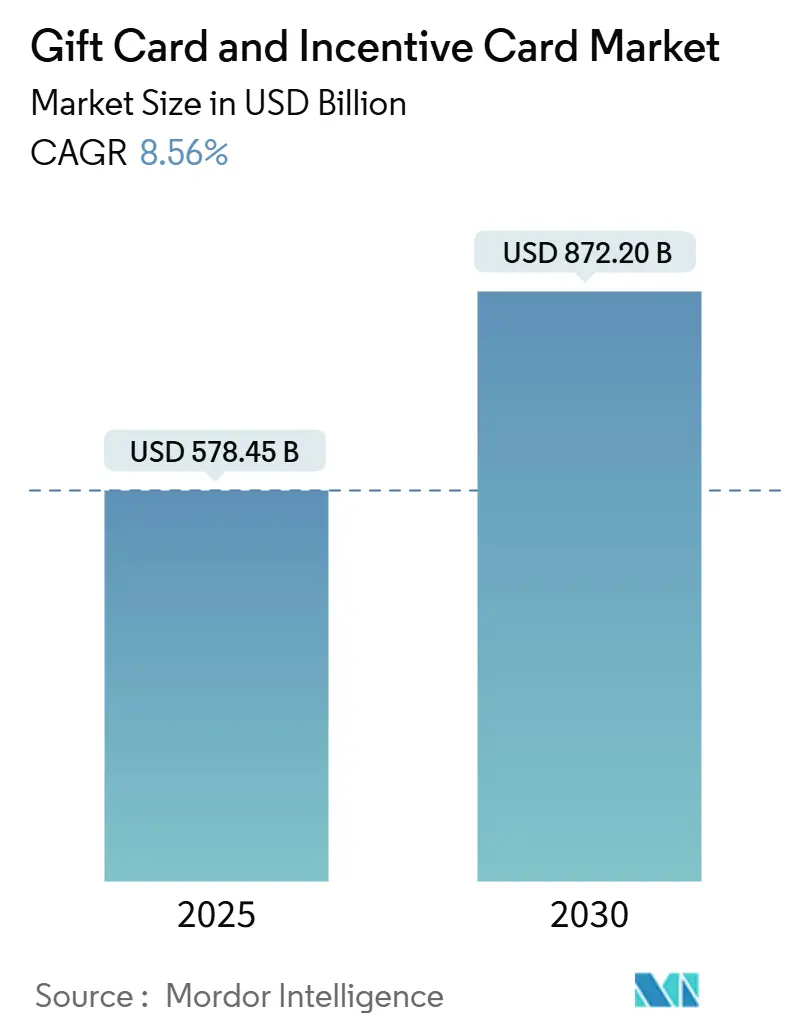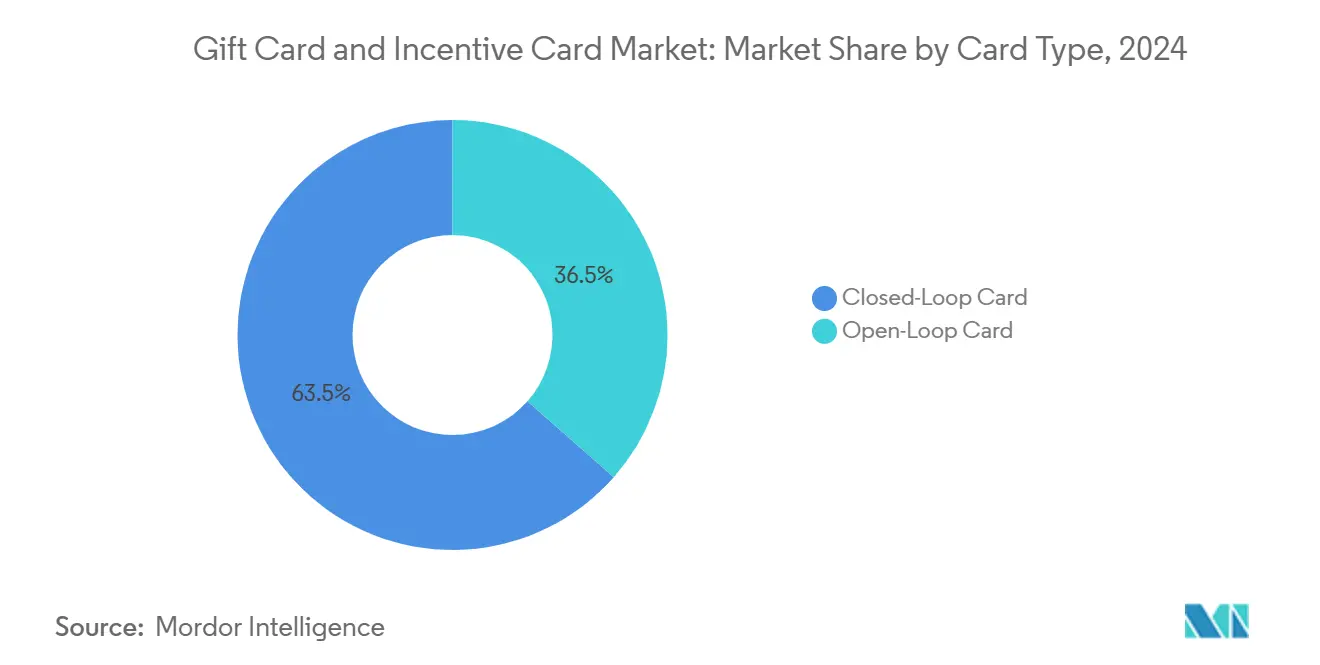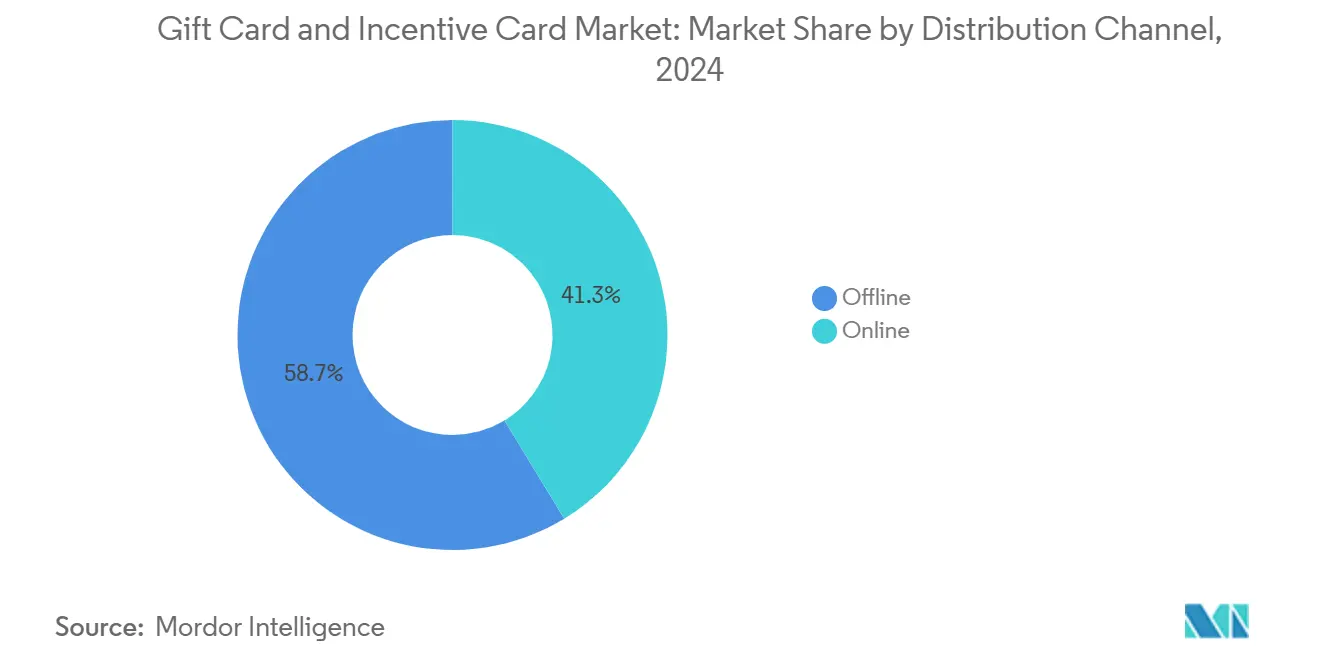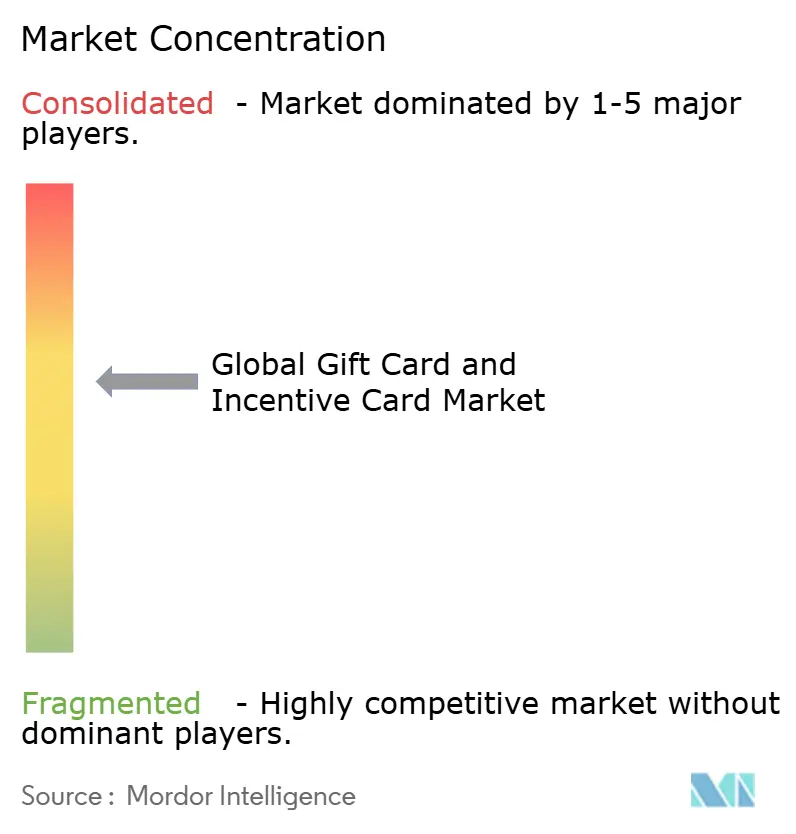
Gift Card And Incentive Card Market Analysis by Mordor Intelligence
The Gift Card And Incentive Card Market size is estimated at USD 578.45 billion in 2025, and is expected to reach USD 872.20 billion by 2030, at a CAGR of 8.56% during the forecast period (2025-2030).
Digital formats, tighter fraud regulations, and corporate demand for flexible incentives sustain this double-digit momentum even as economic conditions fluctuate. Rapid B2B adoption, rising open-loop acceptance, and the spread of mobile payments in emerging economies underpin growth, while sustainability mandates accelerate the shift from plastic to dematerialised products. At the same time, regulatory pressures around fee transparency and cybercrime prevention raise compliance costs, encouraging scale-driven platform strategies across the value chain. Consolidation opportunities arise as fintechs, retailers, and payment networks race to integrate fraud analytics, instant delivery, and cross-border functionality into a single embedded-finance experience.
Key Report Takeaways
- By card type, closed-loop products held 63.5% of the gift card and incentive card market share in 2024, while open-loop offerings are projected to expand at a 9.82% CAGR through 2030.
- By format, physical cards retained 56.8% of the gift card and incentive card market size in 2024; digital cards are expected to grow fastest at a 13.66% CAGR to 2030.
- By consumer type, B2C accounted for 70.2% of the gift card and incentive card market size in 2024; B2B is accelerating at a 10.23% CAGR through 2030.
- By distribution channel, offline outlets controlled 58.7% of the gift card and incentive card market share in 2024, while online channels are projected to rise at a 12.93% CAGR.
- By industry of application, food & beverages led with 28.4% revenue share of the gift card and incentive card market in 2024; consumer electronics is advancing at an 11.12% CAGR through 2030.
- By region, North America held a 40.7% share of the gift card and incentive card market size in 2024; Asia-Pacific is projected to accelerate at a 10.75% CAGR through 2030.
Global Gift Card And Incentive Card Market Trends and Insights
Drivers Impact Analysis
| Driver | (~) % Impact on CAGR Forecast | Geographic Relevance | Impact Timeline |
|---|---|---|---|
| E-commerce boom accelerating digital gift-card adoption | +2.1% | Global, with concentration in North America & APAC | Medium term (2-4 years) |
| Rise of corporate loyalty & incentive programs | +1.8% | North America & EU core, expanding to APAC | Long term (≥ 4 years) |
| Cashless-payment ecosystems & digital wallets proliferation | +1.6% | APAC core, spill-over to MEA and Latin America | Medium term (2-4 years) |
| AI-driven personalization improving breakage economics | +1.3% | Global, early adoption in North America & EU | Long term (≥ 4 years) |
| Sustainability push favoring dematerialized gift cards | +0.9% | EU & North America, expanding globally | Long term (≥ 4 years) |
| Blockchain-secured, cross-border gift-card platforms | +0.7% | Global, pilot implementations in developed markets | Long term (≥ 4 years) |
| Source: Mordor Intelligence | |||
E-commerce Boom Accelerating Digital Gift-Card Adoption
Online marketplaces replace physical inventory with instant codes that arrive within seconds, lowering fulfilment costs and enabling personalised denominations at checkout. Amazon reports that digital options now exceed half of all card transactions, supported by AI recommendations that match value to prior spend patterns. Marketplace reach lets independent merchants tap enterprise-grade gift card infrastructure without capital outlay, widening the gift card and incentice card market to previously underserved sellers and driving network effects that lift average order values.
Cashless-Payment Ecosystems & Digital Wallets Proliferation
Super-apps like Alipay and WeChat Pay fold gift card balances into everyday wallets, allowing cross-border redemption and micro-top-ups without separate log-ins. The integration has been pivotal in APAC, where mobile payments already account for more than four-fifths of retail transactions. Such embedded capability positions gift cards as gateways into broader financial-services uptake, extending the gift card and incentive card market well beyond traditional gifting occasions.
AI-Driven Personalization Improving Breakage Economics
Visa’s VAAI Score applies generative AI to 15 billion historical transactions, cutting false fraud declines and boosting legitimate approval rates[1]Visa Inc., “Visa Payment Passkey Service Press Release,” visa.com. Predictive modelling nudges end-users before expiration, shrinking unredeemed balances and enhancing satisfaction. Providers that reduce breakage while curbing fraud protect margins and gain share in the competitive gift card and incentive card market.
Sustainability Push Favoring Dematerialized Gift Cards
Corporate ESG mandates amplify demand for plastic-free rewards. Eco-certified digital formats and paper alternatives from suppliers such as Ricoh lower lifecycle emissions by more than half versus PVC. Procurement teams now factor carbon disclosure into RFPs, encouraging enterprises to transition volumes to digital, a trend that underpins long-term growth in the gift card and incentive card market.
Restraints Impact Analysis
| Restraint | (~) % Impact on CAGR Forecast | Geographic Relevance | Impact Timeline |
|---|---|---|---|
| Escalating gift-card fraud & cyber-crime | -1.4% | Global, concentrated in North America & EU | Short term (≤ 2 years) |
| Divergent global fee / expiry regulations | -0.8% | Global, varying by jurisdiction | Medium term (2-4 years) |
| Rising open-loop activation & interchange fees for SMEs | -0.6% | North America & EU, expanding globally | Medium term (2-4 years) |
| Tariff-driven cost spikes in plastic card supply chains | -0.4% | Global, manufacturing concentrated in APAC | Short term (≤ 2 years) |
| Source: Mordor Intelligence | |||
Escalating Gift-Card Fraud & Cyber-Crime
Coordinated bot attacks target number enumeration and balance harvesting, compelling issuers to layer tokenisation and biometric verification. Conference proceedings from the Innovative Payments Association cite organised crime moving from opportunistic theft to large-scale portfolio exploits, raising compliance spend and slowing onboarding for small merchants. Heightened scrutiny dampens online issuance velocity, trimming short-term expansion in the gift card and incentive card market.
Divergent Global Fee / Expiry Regulations
From Maryland’s signage rules to the Federal Trade Commission’s all-in-pricing mandate effective May 2025, companies must juggle overlapping statutes that vary by state and country[2]Federal Trade Commission, “Trade Regulation Rule on Unfair or Deceptive Fees,” ftc.gov. Maintaining multiple configurations increases cost-to-serve and discourages cross-border rollouts, creating friction that tempers the otherwise rapid growth of the gift card and incentive card market.
Segment Analysis
By Card Type: Open-Loop Gains Ground Through Network Effects
Closed-Loop issuers currently hold a 63.5% share of the gift card and incentive card market in 2024, defending their position by embedding loyalty points and exclusive perks. The open-loop segment is expected to grow at a 9.82% CAGR over the forecast period, eroding Closed-Loop dominance as consumers value multi-merchant choice. Visa’s Flexible Credential lets users switch funding sources on a single token, broadening acceptance while mitigating interchange exposure for merchants. Corporate bulk purchasers now favour open networks to maximise employee choice, accelerating volume migration. Over the forecast horizon, hybrid credentials combining store-specific benefits with network rails are likely to define competitive advantage in the gift card and incentive card market.
Demand spikes around seasonal gifting sustain Closed-Loop relevance, especially in grocery, fuel, and quick-service retail, where in-venue displays trigger impulse buys. Yet, breakage-driven economics weaken as digital reminders lift redemption rates, nudging issuers to pivot toward experiential bonuses and subscription tie-ins. Overall, rising interoperability is expected to cement Open-Loop credentials as the structural growth driver inside the broader gift card and incentive card market.

Note: Segment shares of all individual segments available upon report purchase
By Format Type: Digital Transformation Accelerates Despite Physical Dominance
Physical formats held 56.8% of the gift card and incentive card market size in 2024, thanks to kiosk sales and the emotional appeal of tangible gifts. Digital cards recorded a 13.66% CAGR to 2030. Instant delivery, zero logistics overhead, and ESG compliance resonate with both enterprises and consumers. Enviricard data show a 57% carbon reduction versus PVC products, meeting Scope 3 reporting needs. Retailers such as Kroger combine the two by offering 4X fuel points for online purchases redeemed in store, blending margin expansion with foot-traffic retention.
Packaging innovations like NFC-embedded paper stock allow authenticity checks via smartphones, closing fraud loopholes that once favoured plastic. As real-time issuance platforms mature, physical inventory is expected to concentrate in high-traffic impulse settings, while corporate and cross-border volumes skew overwhelmingly digital, reinforcing dual-track evolution within the gift card and incentive card market.
By Consumer Type: B2B Segment Drives Innovation Through Corporate Adoption
Although individuals accounted for 70.2% of the gift card and incentive card market size in 2024, corporate programmes will power future gains, with forecasted growth of 10.23%. Firms deploy analytics dashboards that cross-link redemption with productivity, boosting HR budget justification. APIs enable bulk issuance, personalised branding, and automated balance top-ups, functions now standard in the gift card industry ecosystem. Tax-advantaged treatment in multiple jurisdictions further lifts take-up, especially for spot bonuses under USD 100 that bypass payroll overhead.
B2B growth cascades into the consumer sphere as employees re-spend balances at partner merchants, widening the circulating float and enlarging the gift card market. Rising demand for inclusive gift types also spurs reloadable open-loop packs that employees can carry forward, blending compensation and payment utility in one credential.
By Distribution Channel: Online Growth Reshapes Market Economics
Offline grocers and convenience chains still dominate impulse-driven holiday peaks with a 58.7% share of the gift card and incentive card market size in 2024, but shrinking physical shelf space and inventory carrying costs push retailers toward scan-to-buy QR codes that redirect shoppers online, keeping the gift card market fluid across channels. Web and in-app storefronts grew 12.93% annually, capturing corporate bulk orders and partnering with BNPL providers like Klarna to widen ticket affordability. The direct-to-consumer funnel harnesses personalised upsell prompts, lifting attach rates.
Fintech intermediaries aggregate hundreds of brands into single API endpoints, lowering integration hurdles for mobile super-apps and loyalty wallets. As a result, traditional bulk distributors reinvent themselves as omnichannel orchestration layers, reflecting a structural shift toward data-centric value creation in the gift card market.

Note: Segment shares of all individual segments available upon report purchase
By Industry of Application: Electronics Surge Reflects Tech-Driven Consumption
Food & Beverages stays in pole position on frequency and small-ticket suitability with a 28.4% share of the gift card and incentive card market size in 2024, but faces share pressure as consumers funnel discretionary spend into higher-value gadgets. Gift cards tied to electronics retailers are expected to grow at 11.12% CAGR, fueled by remote-work upgrades and rapid product refresh cycles. Apple, Amazon, and specialist chains rank among the most redeemed issuers in Japan, underlining consumer preference for flexible tech spending. Employers also send electronics gift cards to hybrid staff as equipment stipends, further expanding this sub-segment of the gift card market.
Subscription entertainment, gaming, and app-store credits piggyback on electronics growth, deepening ecosystem stickiness. Conversely, fashion and beauty lag as returns, and sizing uncertainty encourages open-loop preferences instead. These divergent trajectories illustrate the granularity of opportunity that continues to broaden the scope of the gift card market.
Geography Analysis
North America retained 40.7% of 2024 revenue on the back of robust digital infrastructure, ingrained gifting culture, and clear consumer-protection laws. The forthcoming FTC directive on full-fee disclosure exemplifies regulatory fine-tuning rather than disruptive overhaul, allowing issuers to innovate around biometric security and AI-driven rewards while maintaining compliance. Enterprises pilot emerging concepts such as crypto-denominated cards, confident that KYC frameworks can adapt swiftly across the region.
Asia-Pacific posted the fastest 10.75% CAGR, propelled by mobile-first commerce and growing middle-class spending. China’s Alipay and WeChat Pay mainstreamed in-app gift balances, leapfrogging plastic adoption stages and anchoring loyalty inside super-apps. Southeast Asian e-marketplaces replicate the model, bundling vouchers with free shipping and BNPL, which extends reach to unbanked consumers. Government cash-transfer schemes in India and Indonesia further accelerate digital voucher usage, expanding the latent pool addressable by the gift card market.
Europe maintains steady expansion, aided by cross-border SEPA payment rails and sustainability mandates encouraging dematerialised formats. Retailers integrate pan-EU e-gifting with VAT-compliant invoicing to serve expatriate communities and tourism corridors. South America and the Middle East & Africa add diversity: Brazil’s payroll card reforms and Gulf states’ hospitality drives pull in new commercial buyers, albeit at different digital maturity levels. These regional mosaics collectively reinforce the global growth map for the gift card market.
Competitive Landscape
The market features a patchwork of scheme owners, processors, distributors, and content licensors. Payment networks such as Visa and Mastercard anchor open-loop rails, while retailers like Walmart and Starbucks guard proprietary ecosystems. Technology specialists Givex, InComm, and WeGift supply white-label platforms that embed compliance, AML, and multi-currency processing, letting merchants launch programmes in weeks rather than months. Blackhawk Network leverages 200,000+ retail doors to remain the largest physical aggregator, yet pivots to API-first issuance to stay relevant in the digital gift card market.
Fintech newcomers differentiate via crypto rewards, micro-commission affiliate models, or ESG credentials. Fold, for example, processed USD 2.5 billion in bitcoin-backed gift volume, attracting digital-native users looking for inflation hedges. Large incumbents counter with AI fraud engines and biometric passkeys; Visa’s 2025 passkey roll-out promises frictionless but secure online redemption. Consolidation momentum is visible as issuers partner with anti-fraud analytics firms and as distributors acquire niche sustainability providers to round out offerings. Overall, platform depth, security posture, and global issuance licences now dictate competitive edge inside the gift card and incentive card market.
Gift Card And Incentive Card Industry Leaders
-
Amazon.com Inc.
-
Apple Inc.
-
Walmart Inc.
-
Blackhawk Network Holdings Inc.
-
InComm Payments
- *Disclaimer: Major Players sorted in no particular order

Recent Industry Developments
- June 2025: Bitget Wallet enhanced stablecoin payments for instant card issuance at Solana Summit 2025, enabling direct crypto-to-voucher checkout.
- May 2025: Visa launched the Visa Payment Passkey Service, adding biometric verification to digital card transactions.
- March 2025: Klarna extended its Gift Card Store to Germany, Italy, and the Netherlands in partnership with Blackhawk Network.
- January 2025: PAR Technology released an integrated gift card suite for restaurants and retailers with real-time analytics.
Research Methodology Framework and Report Scope
Market Definitions and Key Coverage
Our study treats the gift card and incentive card market as the total face value of open-loop and closed-loop cards, physical or digital, issued for consumer gifting or for corporate rewards and loyalty programs, across retail, travel, hospitality, and digital platforms worldwide.
Scope exclusion: prepaid debit products meant for general spending or payroll disbursement are outside this definition.
Segmentation Overview
- By Card Type
- Open-Loop Card
- Closed-Loop Card
- By Format Type
- Digital Card
- Physical Card
- By Consumer Type
- Individual (B2C)
- Corporate (B2B)
- By Distribution Channel
- Online
- Offline
- By Industry of Application
- Food and Beverages
- Health, Wellness, and Beauty
- Apparel, Footwear, and Accessories
- Consumer Electronics
- Other Industries
- By Region
- North America
- United States
- Canada
- Mexico
- South America
- Brazil
- Argentina
- Chile
- Colombia
- Rest of South America
- Europe
- United Kingdom
- Germany
- France
- Spain
- Italy
- Benelux (Belgium, Netherlands, and Luxembourg)
- Nordics (Sweden, Norway, Denmark, Finland, and Iceland)
- Rest of Europe
- Asia-Pacific
- China
- India
- Japan
- South Korea
- Australia
- South-East Asia (Singapore, Indonesia, Malaysia, Thailand, Vietnam, and Philippines)
- Rest of Asia-Pacific
- Middle East and Africa
- United Arab Emirates
- Saudi Arabia
- South Africa
- Nigeria
- Rest of Middle East and Africa
- North America
Detailed Research Methodology and Data Validation
Primary Research
Mordor interviewers survey issuers, program managers, B2B distributors, and large employers in North America, Europe, Asia-Pacific, and the GCC. Dialogues confirm average load values, breakage, and the share of incentives in total volume, letting us close gaps left by desk work.
Desk Research
We first map the payment landscape using publicly available series from central banks, BIS Red Book tables, the World Bank Global Findex, and card-network disclosures. Trade bodies such as the Gift Card & Voucher Association, National Retail Federation, and Ecommerce Europe help us size B2C flows, while white papers from fintech watchdogs enrich our view on digital breakage rates. Company 10-Ks, investor decks, and news archived in Dow Jones Factiva and D&B Hoovers provide issuer-level revenue clues. These sources illustrate but do not exhaust the wider pool reviewed by Mordor analysts.
Market-Sizing & Forecasting
We reconstruct the 2024 baseline with a top-down roll-up of card load and redemption data reported by regulators and schemes. We then cross-check it with bottom-up samples of leading issuers' volumes multiplied by blended ASPs. Key variables like e-commerce penetration, smartphone adoption, corporate reward outlays, digital wallet usage, and inflation-adjusted face values feed a multivariate regression to project demand through 2030. Where issuer data are partial, regional averages inferred from primary interviews bridge the gap.
Data Validation & Update Cycle
Outputs pass breakage ratio checks, currency reconversions, and peer review by a senior analyst panel. We refresh every twelve months and re-open the model whenever a material event, for example, new interchange rules, shifts the underlying metrics.
Why Mordor's Gift Card and Incentive Card Baseline Commands Confidence
Published estimates often diverge; scopes, face value definitions, and refresh cadences rarely align. By anchoring on regulator-verified transaction data and validating with live issuer feedback, Mordor limits noise and yields a balanced midpoint buyers can rely on.
Key gap drivers include whether breakage is netted, if corporate incentives are counted, the choice between gross loads versus active balances, and how multi-currency values are translated. Faster refreshes and our blended top-down and bottom-up logic further narrow variance.
Benchmark comparison
| Market Size | Anonymized source | Primary gap driver |
|---|---|---|
| USD 578.45 B (2025) | Mordor Intelligence | - |
| USD 1.24 T (2025) | Global Consultancy A | Adds transit and telecom stored value not in our scope |
| USD 614.7 B (2025) | Industry Databook B | Uses gross loads and single-day FX conversion |
| USD 271.2 B (2024) | Regional Forecasting C | Excludes corporate incentive and physical cards |
In short, our disciplined variable selection, timely updates, and transparent reconciliation steps give decision-makers a dependable, reproducible baseline, while alternative figures, though insightful, reflect different and less validated constructs.
Key Questions Answered in the Report
What is the current value of the gift card market?
The gift card market is valued at USD 578.45 billion in 2025 and is forecast to grow to USD 872.20 billion by 2030 at an 8.56% CAGR.
Which segment is growing fastest within the gift card market?
Digital cards lead growth at a 13.66% CAGR, spurred by instant delivery, lower logistics costs, and corporate ESG mandates.
Why are open-loop cards gaining popularity?
Open-loop cards offer multi-merchant acceptance, align with employee-choice incentives, and integrate seamlessly with digital wallets, driving a 9.82% CAGR.
How do regulations impact the gift card market?
Regulatory changes such as the US FTC fee-disclosure rule and state-level anti-fraud acts increase compliance costs but also boost consumer trust, supporting sustainable growth.
Which region offers the highest growth potential?
Asia-Pacific shows the fastest expansion at 10.75% CAGR, driven by mobile-first payment ecosystems and a rising middle class.
How are corporations using gift cards in HR programmes?
Companies deploy gift cards as tax-advantaged rewards, track redemption analytics to measure engagement, and provide employees with flexible, multi-merchant spending options.
Page last updated on:



